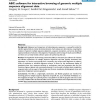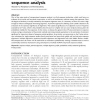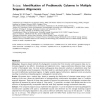97 search results - page 8 / 20 » An evolutionary progressive multiple sequence alignment |
122
click to vote
BMCBI
2004
15 years 5 days ago
2004
Background: Alignment and comparison of related genome sequences is a powerful method to identify regions likely to contain functional elements. Such analyses are data intensive, ...
110
click to vote
BMCBI
2006
15 years 11 days ago
2006
Background: Molecular evolutionary studies of noncoding sequences rely on multiple alignments. Yet how multiple alignment accuracy varies across sequence types, tree topologies, d...
BIB
2006
15 years 11 days ago
2006
One of the major goals of computational sequence analysis is to find sequence similarities, which could serve as evidence of structural and functional conservation, as well as of ...
96
Voted
ALMOB
2008
15 years 13 days ago
2008
Motivation: Sequence-based methods for phylogenetic reconstruction from (nucleic acid) sequence data are notoriously plagued by two effects: homoplasies and alignment errors. Larg...
130
click to vote
BMCBI
2011
14 years 6 months ago
2011
Background: The Monte Carlo simulation of sequence evolution is routinely used to assess the performance of phylogenetic inference methods and sequence alignment algorithms. Progr...



